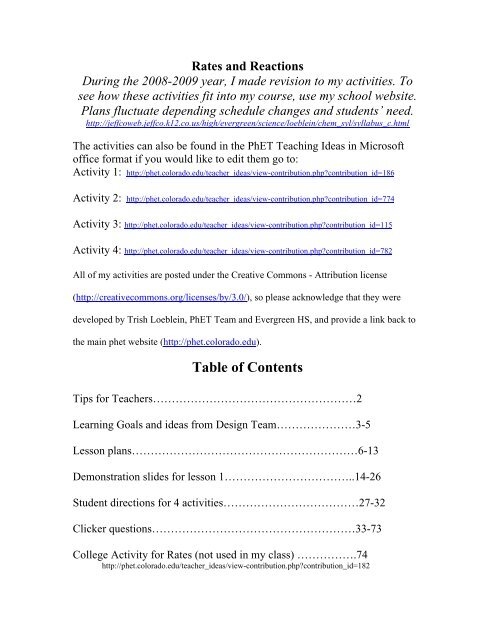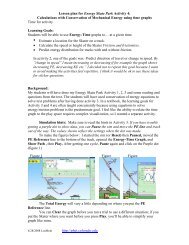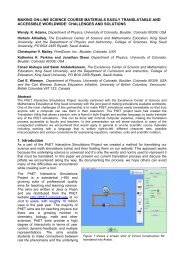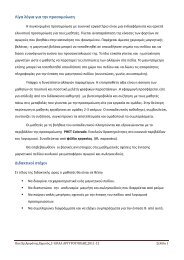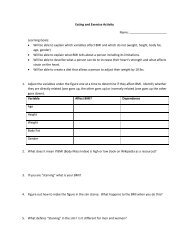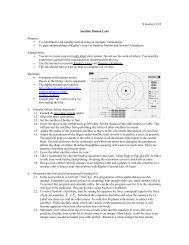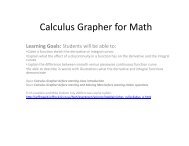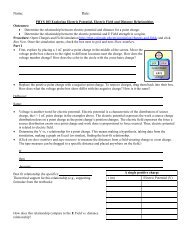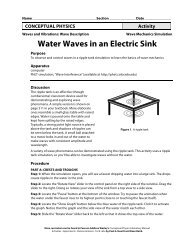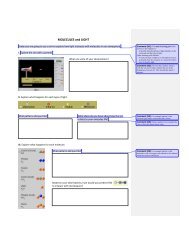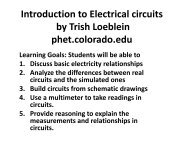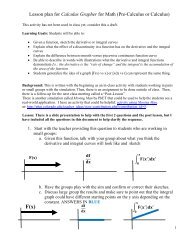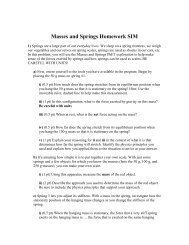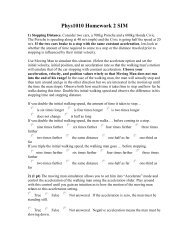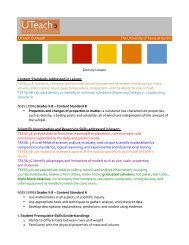Reactions and Rates Guide with 4 lessons.pdf - PhET
Reactions and Rates Guide with 4 lessons.pdf - PhET
Reactions and Rates Guide with 4 lessons.pdf - PhET
You also want an ePaper? Increase the reach of your titles
YUMPU automatically turns print PDFs into web optimized ePapers that Google loves.
<strong>Rates</strong> <strong>and</strong> <strong>Reactions</strong>During the 2008-2009 year, I made revision to my activities. Tosee how these activities fit into my course, use my school website.Plans fluctuate depending schedule changes <strong>and</strong> students’ need.http://jeffcoweb.jeffco.k12.co.us/high/evergreen/science/loeblein/chem_syl/syllabus_c.htmlThe activities can also be found in the <strong>PhET</strong> Teaching Ideas in Microsoftoffice format if you would like to edit them go to:Activity 1: http://phet.colorado.edu/teacher_ideas/view-contribution.php?contribution_id=186Activity 2: http://phet.colorado.edu/teacher_ideas/view-contribution.php?contribution_id=774Activity 3: http://phet.colorado.edu/teacher_ideas/view-contribution.php?contribution_id=115Activity 4: http://phet.colorado.edu/teacher_ideas/view-contribution.php?contribution_id=782All of my activities are posted under the Creative Commons - Attribution license(http://creativecommons.org/licenses/by/3.0/), so please acknowledge that they weredeveloped by Trish Loeblein, <strong>PhET</strong> Team <strong>and</strong> Evergreen HS, <strong>and</strong> provide a link back tothe main phet website (http://phet.colorado.edu).Table of ContentsTips for Teachers………………………………………………2Learning Goals <strong>and</strong> ideas from Design Team…………………3-5Lesson plans……………………………………………………6-13Demonstration slides for lesson 1……………………………..14-26Student directions for 4 activities………………………………27-32Clicker questions………………………………………………33-73College Activity for <strong>Rates</strong> (not used in my class) …………….74http://phet.colorado.edu/teacher_ideas/view-contribution.php?contribution_id=182
<strong>PhET</strong> Tips for Teachers<strong>Reactions</strong> <strong>and</strong> <strong>Rates</strong>Non-obvious controls:• Be sure to try all the different tabs at the top of the simulation. The concepts increase indifficulty as you move to the right tabs.• You can Pause the sim <strong>and</strong> then use Step to incrementally analyze.• If you are doing a lecture demonstration, set your screen resolution to 1024x768 so thesimulation will fill the screen <strong>and</strong> be seen easily.Important modeling notes / simplifications:• This simulation is designed to help students visualize reversible reactions, but the numberof particles is small, so quantitative data is not a reasonable expectation.• When you use the launcher in the straight shot mode, only the shot is straight on. Theparticles do not follow a linear path strictly.• The total energy displayed represents the sum of kinetic + potential. If two particlescollide, but at grazing angles or one from behind the other, not all of the kinetic energy isavailable to go into the reaction so there may not be enough for a reaction even thoughthe total energy is greater than the barrier height.• The collision model is simplified to be a basic elastic collision <strong>with</strong> the change inpotential energy accounted for immediately after collision by appropriately adjusting thekinetic energy.• When you add/remove energy using the <strong>PhET</strong> heater/cooler, the energy change isinstantaneously seen in the particles. In real-life, the container would change temperature<strong>and</strong> then the particles would change energy through collisions, radiation, <strong>and</strong> convection.In this simulation, the simplification is made because the learning goals are focused onreactions <strong>and</strong> rates <strong>and</strong> not on energy transfer.• The particle size is not part of the calculations. Different colors <strong>and</strong> sizes were used tohelp student’ visualization.• If you want to have students use a molecular model to calculate equilibrium constants,use Salts <strong>and</strong> Solubility where the data is more consistent <strong>and</strong> the values can be verifiedusing a literature search,Insights into student use / thinking:• There is a comprehensive list of learning goals from the design team published in theTeaching Ideas <strong>and</strong> Activities section written by Loeblein <strong>and</strong> Koch.http://phet.colorado.edu/teacher_ideas/view-contribution.php?contribution_id=163Suggestions for sim use:• The simulations have been used successfully <strong>with</strong> homework, lectures, in-class activities, or labactivities. Use them for introduction to concepts, learning new concepts, reinforcement ofconcepts, as visual aids for interactive demonstrations, or <strong>with</strong> in-class clicker questions. To readmore, see Teaching Physics using <strong>PhET</strong> Simulations• Inquiry strategies take advantage of the simulation design. Invite the students to play <strong>with</strong> thesimulation <strong>with</strong>out any instruction. Use a guided inquiry approach to learning or ask conceptquestions. For help <strong>with</strong> creating effective guided inquiry activities or questions, see: <strong>Guide</strong>linesfor Contributions or Concept Questions• For activities <strong>and</strong> lesson plans written by the <strong>PhET</strong> team <strong>and</strong> other teachers, see: Teacher Ideas& ActivitiesWritten by Trish Loeblein, Kathy Perkins last updated July 29, 2009 1
Learning goals for <strong>Reactions</strong> <strong>and</strong> <strong>Rates</strong> simulation: The numbered items are measurablelearning goals that the development team wrote. Some hints for the teacher are providedunder the bullets items.First panel, Single Collision1. Describe reactions in terms of a simple molecular model.• For this goal, I want the students to use the model presented on the SimpleCollision tab. This is not a model that is presented in texts, but the <strong>PhET</strong> teamthought that a 1D model might help students focus on just a few things: not allcollisions result in a new substance <strong>and</strong> reactions are reversible. <strong>Reactions</strong> arethe result of collisions <strong>and</strong> the products may collide <strong>and</strong> react to give reactants2. Explain how the simulation model relates to test tube size experiments• Real reaction vessels don’t have a molecular shooter, what is it modeling?Explain how you used it to test your ideas about how reactions occur.• When you pull out the shooter, it acts like stretching a spring so the moleculegets elastic potential energy; when you let go, the energy is converted to Kineticenergy <strong>and</strong> gives the molecule speed just like heating the container would.• The shooter could represent pouring the substances together <strong>and</strong> stirring <strong>with</strong>variable vigor.3. Students will describe on a microscopic level, what contributes to a successfulreaction. (Include illustrations)• Make sure your students pull the shooter a variety of distances <strong>and</strong> change theangle• <strong>Reactions</strong> are the result of collisions between molecules. Whether a collisionleads to products or not is determined by both the speed (energy) <strong>and</strong> angle ofthe collision. It may be difficult for the students to see the effect of the angle, butif you have the shooter on an angle <strong>and</strong> pull it out so that the Total energy isabove the activation energy, the collisions produce a reactant only if the angle isappropriate.• <strong>Reactions</strong> are reversible <strong>and</strong> they can experiment forward <strong>and</strong> reverse byselecting a different species to shoot.• Students may describe things they discover about the reaction coordinate heretoo. See the note in #34. Students will describe what would enable a reaction proceed or slow its progress<strong>with</strong> references to the reaction coordinate.• Based on the reaction coordinate <strong>and</strong> the energy of the reactants, studentsshould be able to predict if a collision <strong>with</strong> a given energy will lead to products.• For reactants that do not have enough energy to react, students should be able topropose how they could make the reaction happen through changes intemperature or use of a catalyst. They can’t add anything that looks like a
catalyst, but they can change the activation energy by selecting Design yourOwn. Alternately, in order to stop a reaction from happening, they couldpropose how they could slow down or stop the reaction through changes intemperature or use of a catalyst.• <strong>Reactions</strong> can proceed at lower temperatures if the activation energy is lowered.In a real reaction, this is done <strong>with</strong> catalyst.• For the reaction to occur, reactant molecules must have sufficient energy toovercome the activation energy. Heating <strong>and</strong> cooling molecules will changetheir energy, <strong>and</strong> as a result will change the probability of successful collisions.5. Students will use the potential energy diagram to determine• The activation energy for the forward <strong>and</strong> reverse reactions,• The difference in energy between reactants <strong>and</strong> products.• The relative potential energies of the molecules at different positions on areaction coordinate6. The reaction coordinate shows how potential energy changes <strong>with</strong> the separationof reactants <strong>and</strong> products.• The reaction coordinate shows the relative potential energies of the reactants,products, <strong>and</strong> the transition state.• Different chemical reactions will have different reaction coordinates.Second Panel, Many Collisions1. Describe reactions in terms of molecular models <strong>with</strong> illustrations.• The description should include: A chemical reaction given in the form A+BC↔AB+ C or AB+CD ↔ AD +CB represents a large number of particles colliding<strong>and</strong> reorganizing to make new substances; Not every collisions results in areaction; reactions are reversible.2. Use the molecular model to explain why reactions are not instantaneous.<strong>Reactions</strong> are the result of collisions <strong>and</strong> that takes time. They may observe that ratesvary, but since I don’t plan to have them open the Reaction coordinate, they may nothave an explanation for the observations.3. Use the molecular model to explain why reactions have less than 100% yields.Since reactions are reversible, even though products are being formed, they arereacting to make reactants, so there may not be 100% yield. We will have done a labwhere they make rice crispy bars <strong>and</strong> I want to make sure that their explanationsinclude more than a physical explanation that some reactants may stick to thecontainer <strong>and</strong> not be able to collide. They may observe that rates vary, but since Idon’t plan to have them open the Reaction coordinate, they may not have anexplanation for the observations.3. Students will sketch how the number of reactants <strong>and</strong> products will change as areaction proceeds
4. Students will be able to determine the number of reactants or products from theexperiment graph.5. Convert number to concentration• Estimate the size of the container from the number of atoms across a side. Makean assumption for the depth of the container, the only parameter of the volumethat isn’t visible. From your estimate of the volume, <strong>and</strong> the number of atoms ormolecules present, calculate the concentration.6. Students will relate changes observed in the rate of reaction for a system ofmany molecules to changes at the molecular level, such as changes in the energyof molecules, or in the potential energy along the reaction coordinate.• Just as heating <strong>and</strong> cooling will change the probability of a single reactionhappening, heating <strong>and</strong> cooling will change the rate at which multiple reactantmolecules proceed to form products.Equilibrium concepts that could be achieved in either the second or third panel:1. Students will explain how they know that a system has reached equilibrium froma graph of number of reactants <strong>and</strong> products versus time.2. Students will predict how raising or lowering the temperature will affect asystem in the equilibrium position.3. Students will describe the relative sizes of the forward <strong>and</strong> reverse rates atequilibrium.4. Students will explain what effects whether the equilibrium position favors theproducts or the reactants.5. Students can predict how addition of a reactant or product will affect theforward <strong>and</strong> reverse reaction rates, <strong>and</strong> once this new system reachesequilibrium how the reactant <strong>and</strong> product concentrations will compare to theoriginal system at equilibrium.Third Panel, Rate Experiments1. Students can calculate a rate coefficient from concentration <strong>and</strong> time data.2. Students can determine how a rate coefficient changes <strong>with</strong> temperature fromconcentration vs. time data collected at different temperatures.3. Students should be able to compare graphs of concentration vs. time to determinewhich represents the fastest or slowest rate.
Lesson plan for <strong>Reactions</strong> <strong>and</strong> <strong>Rates</strong> 1: Introduction to reactions2 50 minute periods untestedLearning Goals: I have put notes in italics after the learning goals to explain my thinking <strong>and</strong>also describe what might be included in an acceptable answer.Students will be able to:1. Describe reactions in terms of a simple molecular model. For this goal, I want thestudents to use the model presented on the Simple Collision tab. This is not a model thatis presented in texts, but the <strong>PhET</strong> team thought that a 1D model might help studentsfocus on just a few things: not all collisions result in a new substance <strong>and</strong> reactions arereversible. <strong>Reactions</strong> are the result of collisions <strong>and</strong> the products may collide <strong>and</strong> reactto give reactants (This tab can be used to help simplify the relationships betweenreactions <strong>and</strong> the energy diagrams, but this is not a learning goal for this activity)2. Describe reactions in terms of molecular models <strong>with</strong> illustrations. The descriptionshould include: A chemical reaction given in the form A+BC↔ AB+ C or AB+CD ↔AD +CB represents a large number of particles colliding <strong>and</strong> reorganizing to make newsubstances; Not every collisions results in a reaction; reactions are reversible.3. Differentiate between dissolving <strong>and</strong> reacting. The Salts simulation doesn’t showwater, so the students will not see the agent or process for dissolving. I have not testedthis goal, so I’ll see if they can use the simulations to differentiate. The difference is thatthe substance is unchanged; the ions can organize into groups (crystals) or break apart(hydrate). In reactions, the particles combine <strong>with</strong> different particles to make differentsubstances.4. Use the molecular model to explain why reactions are not instantaneous. <strong>Reactions</strong>are the result of collisions <strong>and</strong> that takes time. They may observe that rates vary, butsince I don’t plan to have them open the Reaction coordinate, they would not have anexplanation for the observations.5. Use the molecular model to explain why reactions have less than 100% yields. Sincereactions are reversible, even though products are being formed, they are reacting tomake reactants, so there may not be 100% yield. We will have done a lab where theymake rice crispy bars <strong>and</strong> I want to make sure that their explanations include more thana physical explanation that some reactants may stick to the container <strong>and</strong> not be able tocollide. They may observe that rates vary, but since I don’t plan to have them open theReaction coordinate, they would not have an explanation for the observations.Background: We will have used Salts <strong>and</strong> Solubility simulation in the activity titled: Activity 1Introduction to Salts-Underst<strong>and</strong>ing ionic formulas. Therefore my students will be a littlefamiliar <strong>with</strong> molecular illustrations; also my students used the Kinetic Molecular theory inphysics the preceding year. My students have not had a chemistry course previously. I plan touse this activity before using the introduction to chemical reactions in the text. This in introducedin Chemistry 6 th edition by Zumdahl Balancing equations (3.6 & 3.7).Teaching note: This is a complex simulation <strong>and</strong> I have other activities that use this simulationfor <strong>Rates</strong> <strong>and</strong> Thermodynamics.Lesson:This lesson starts <strong>with</strong> a demonstration of iron chloride <strong>and</strong> potassium thiocyanide <strong>and</strong>uses the simulation <strong>and</strong> a power point presentation projected to facilitate a class discussion. I do2/27/2008 Loeblein http://phet.colorado.edu
Lesson plan for <strong>Reactions</strong> <strong>and</strong> <strong>Rates</strong> 2: Introduction to Reaction Kinetics <strong>with</strong> Single CollisionsRevised for College ChemistryBackground: I teach a dual credit chemistry course using Chemistry 6 th Edition ZumdahlHoughton Mifflin, NY, 2003. The students in my class are taking their first high schoolchemistry course <strong>and</strong> receive credit for the first semester of college chemistry <strong>and</strong> credit for thecorresponding lab. I used this lesson as part of introduction to spontaneity. Originally, this was 2<strong>lessons</strong>, but I discovered that the students learned more from the first activity than I expected, soI took out some steps. I have written another activity ( still called # 4) using the <strong>Reactions</strong> <strong>and</strong><strong>Rates</strong> simulation to be used in the Kinetics unit second semester along <strong>with</strong> two Soluble Saltactivities (3 <strong>and</strong> 4 in the series of 5).Learning Goals for activity 2 Introduction to reaction kinetics <strong>with</strong> Single collisions: Studentswill be able to:• Describe how the reaction coordinate can be used to predict whether a reaction will proceedincluding how the potential energy of the system changes.• Describe what affects the potential energy of the particles <strong>and</strong> how that relates to the energygraph. Answer: distance <strong>and</strong> type of particle• Describe how the reaction coordinate can be used to predict whether a reaction will proceedslowly, quickly or not at all.• Use the potential energy diagram to determine:o The approximate activation energy for the forward <strong>and</strong> reverse reactions.o The sign difference in energy between reactants <strong>and</strong> products.• Draw a potential energy diagram from the energies of reactants <strong>and</strong> products <strong>and</strong> activationenergy.<strong>Reactions</strong> <strong>and</strong> <strong>Rates</strong> Introduction: I did have to remind many students to select “view” todisplay the graphs on the right side which they need to fully meet the goals.Lesson for Activity 2:Demonstration: Mix solutions of iron (III) nitrate <strong>and</strong> sodium thiocyanide. This is nice because itforms a complex instead of a precipitateMy students work in pairs <strong>and</strong> use the lab sheet for guidance. I predict that it will be important tocheck that the students discover that the shooter can be used to get low energy <strong>and</strong> they mayhave trouble underst<strong>and</strong>ing the difference between potential <strong>and</strong> total energy. The activity tookmost of my college chemistry students one 50 minute period, but some had to finish outside ofclasstime.First panel, Single Collision1. Students will describe on a microscopic level, what contributes to a successful reaction.(Include illustrations)• Make sure your students pull the shooter a variety of distances <strong>and</strong> change the angle• <strong>Reactions</strong> are the result of collisions between molecules. Whether a collision leads toproducts or not is determined by both the speed (energy) <strong>and</strong> angle of the collision. Itmay be difficult for the students to see the effect of the angle, but if you have the12/9/2008 Loeblein http://phet.colorado.edu
Lesson plan for <strong>Reactions</strong> <strong>and</strong> <strong>Rates</strong> 2: Introduction to Reaction Kinetics <strong>with</strong> Single CollisionsRevised for College Chemistryshooter on an angle <strong>and</strong> pull it out so that the Total energy is above the activationenergy, the collisions produce a reactant only if the angle is appropriate.• <strong>Reactions</strong> are reversible <strong>and</strong> they can experiment forward <strong>and</strong> reverse by selecting adifferent species to shoot.• Students may describe things they discover about the reaction coordinate here too. Seethe note in #32. Describe how the reaction coordinate can be used to predict whether a reaction will proceedincluding how the potential energy of the system changes.• Based on the reaction coordinate <strong>and</strong> the energy of the reactants, students should beable to predict if a collision <strong>with</strong> a given energy will lead to products.• For reactants that do not have enough energy to react, students should be able topropose how they could make the reaction happen through changes in temperature oruse of a catalyst. They can’t add anything that looks like a catalyst, but they can changethe activation energy by selecting Design your Own. Alternately, in order to stop areaction from happening, they could propose how they could slow down or stop thereaction through changes in temperature or use of a catalyst.• <strong>Reactions</strong> can proceed at lower temperatures if the activation energy is lowered. In areal reaction, this is done <strong>with</strong> catalyst.• For the reaction to occur, reactant molecules must have sufficient energy to overcomethe activation energy. Heating <strong>and</strong> cooling molecules will change their energy, <strong>and</strong> as aresult will change the probability of successful collisions.3. Students will use the potential energy diagram to determine1. The activation energy for the forward <strong>and</strong> reverse reactions,2. The difference in energy between reactants <strong>and</strong> products.3. The relative potential energies of the molecules at different positions on a reactioncoordinate• Number 1 <strong>and</strong> 2 are traditionally in texts <strong>and</strong> there are usually practice problems. Fornumber 3, students can observe how the distance between the molecules relates to thereaction coordinate. As the particles get close together, the energy increases. This isusually illustrated in texts as well.5. Students will draw a potential energy diagram from the energies of reactants <strong>and</strong> products <strong>and</strong>activation energy.• The reaction coordinate shows how potential energy changes <strong>with</strong> the separation ofreactants <strong>and</strong> products.• The reaction coordinate shows the relative potential energies of the reactants, products,<strong>and</strong> the transition state.• Different chemical reactions will have different reaction coordinates.12/9/2008 Loeblein http://phet.colorado.edu
Lesson plan for <strong>Reactions</strong> <strong>and</strong> <strong>Rates</strong> 3: Equilibrium Introduction(Macroscopic Description, Q, Temperature, <strong>and</strong> Reaction Coordinate)Time for activity: 90 minutes of class <strong>and</strong> some homeworkLearning Goals: Students will be able to:• Use a physical experiment to model chemical equilibrium• Sketch how the number of reactants <strong>and</strong> products will change as a reaction proceeds• Predict how changing the initial conditions will affect the equilibrium amounts ofreactants <strong>and</strong> products. (Amounts of chemicals, temperature which also effects K)• Predict how the shape of the reaction coordinate will affect the equilibrium amounts ofreactants <strong>and</strong> products.Background:<strong>Reactions</strong> <strong>and</strong> <strong>Rates</strong> activity 1 was done in September, #2 was done in December, 3 <strong>and</strong> 4 willbe done in the same unit in March.I used Amy Jordan’s activity http://phet.colorado.edu/teacher_ideas/viewcontribution.php?contribution_id=475in 2009 <strong>and</strong> decided to make some changes based on mystudents’ comments. One thing that my students said are that they wished they had more timeto explore <strong>with</strong> the water exchange equilibrium <strong>and</strong> that they felt that they could do the <strong>PhET</strong>part for homework, so I put the water experiments first. This version is a combination ofAmy’s lab <strong>and</strong> my changes to the <strong>PhET</strong> directions.Amy Jordan wrote to me after she used her activity: “I think it was successful in workingthrough the students' misconceptions about equilibrium, <strong>and</strong> how temperature affectsequilibrium position. For one thing, almost all students predicted that when temperature wasraised to above the activation energy bump, there would be all product <strong>and</strong> no reactants left---then they learned that temperature does affect equilibrium position, but not in the way theythought!”<strong>Reactions</strong> <strong>and</strong> <strong>Rates</strong> Introduction: My students had used the simulation <strong>and</strong> did not need helpfiguring out how to use the third panel. They commented that the <strong>PhET</strong> part could be doneoutside of class. The simulation is meant for qualitative concept development. There is muchvariation in values because of the small number of particles. I experimented <strong>with</strong> just usingdifferent amounts of reactants only <strong>and</strong> only 2 temperatures (the default <strong>and</strong> a value thatwould be just above the activation energy). The results give qualitative data that supportsliterature expectations. If you want to get quantitative values for the equilibrium constant, K,use the simulation called Salts <strong>and</strong> Solubility; the data for K sp are easily verified in solubilitytables.Lesson:There is an experiment that precedes the use of the simulation. After Part A Step 4, I think itwould be helpful to talk to students about whether they think this situation represents a newtype of reaction or just new initial conditions. I think that some students thought that the newconditions represented a new reaction coordinate partly because they used the sim before theydid the lab. I have not decided how to best address question 8, but I think we should at leasthave a class discussion about that there could be a way to optimize the initial conditions.For Part B, question 2, I will assign groups different reactions (one reaction per group) <strong>and</strong>we will share our results on another day. I hope to arrange for this to happen in class if I canget the computer lab.Post-Lesson: There are some clicker questions.7/28/2009 Loeblein http://phet.colorado.edu
Lesson plan for <strong>Reactions</strong> <strong>and</strong> <strong>Rates</strong> 4: Equilibrium LeChatlierIncludes the use of Salts <strong>and</strong> Solubility <strong>and</strong> Phases of MatterThis was adapted from an activity by Amy Jordanhttp://phet.colorado.edu/teacher_ideas/view-contribution.php?contribution_id=673Time for activity: I plan to use this as a homeworkLearning Goals:Students will be able to:• Explain how to make an equilibrium system change <strong>and</strong> predict what changes willhappen. I have included guiding questions so that the students will have to use bothmacroscopic <strong>and</strong> molecular ideas. I use that wording often in the learning goals, <strong>and</strong> Idon’t want them to become too repetitive, so I left it off the student directions.• Compare <strong>and</strong> contrast salt-solution, phase, <strong>and</strong> chemical equilibriums.Teaching notes: The basic goal of this activity is for students to build their own underst<strong>and</strong>ingof how to use LeChatelier’s Principle to predict equilibrium changes caused by concentration<strong>and</strong> temperature, but I tried to write the goals <strong>and</strong> questions in “student language”. They canexplore concentration effects <strong>with</strong> Salts <strong>and</strong> Solubility <strong>and</strong> <strong>Reactions</strong> <strong>and</strong> <strong>Rates</strong>. I decided toconstrain the salt solution equilibrium to the amount of water, because I wanted to make theassignment a reasonable length <strong>and</strong> not too redundant. Students can see temperature effects usingStates of Matter <strong>and</strong> different energy curves in <strong>Reactions</strong> <strong>and</strong> <strong>Rates</strong>, (but not <strong>with</strong> Salts <strong>and</strong>Solubility). I was hoping to use States of Matter, to investigate the effects of pressure, but itdidn’t work out because the temperature rise as work is being done is difficult to counteract.I think a good lab that could be done to help <strong>with</strong> underst<strong>and</strong>ing about how temperature effectssalt solution equilibrium would include using a salt that has an endothermic dissolving process<strong>and</strong> one that is exothermic. My plan is to have a class discussion as opposed to doing a lab.Background: I plan to use this activity in combination <strong>with</strong> labs. You can see my unit scheduleon my website. I wrote this activity in the summer of 2009, so the schedule may not show its useuntil fall 09.http://jeffcoweb.jeffco.k12.co.us/high/evergreen/science/loeblein/chem_syl/syllabus_c.htmlMy students will have done the following activities which are linked to the location on the <strong>PhET</strong>site: the first two Salts <strong>and</strong> Solubility, the first three <strong>Reactions</strong> <strong>and</strong> <strong>Rates</strong>, <strong>and</strong> States of Matterphasechange <strong>and</strong> diagramsThey will have done <strong>Reactions</strong> <strong>and</strong> <strong>Rates</strong> #3 just days before.Lesson:I will have a test tube, some salt <strong>and</strong> water available <strong>and</strong> do a demo by just putting enough salt inthe test tube that I expect some to be undissolved. Ask a student volunteer to draw a “test tube”<strong>and</strong> “close up view” of what is going on at the board. I will emphasize that this is an inquiryintroduction to equilibrium not a “learn it all” experience. Have the students use the lab sheetfor guidance.Simulation Introduction: You may want to ask a student demonstrate “saturated solution” inSalts <strong>and</strong> Solubility to help students differentiate between unsaturated, saturated <strong>and</strong> a solution<strong>with</strong> undissolved crystal. Have another student, demonstrate “reaction equilibrium” using<strong>Reactions</strong> <strong>and</strong> <strong>Rates</strong>. Discuss that one represents a “Physical system” <strong>and</strong> the other “ChemicalSystem.” I have found that if you use a total of around 180 particles, the data is more consistent.7/11/2009 Loeblein http://phet.colorado.edu
Lesson plan for <strong>Reactions</strong> <strong>and</strong> <strong>Rates</strong> 4: Equilibrium LeChatlierIncludes the use of Salts <strong>and</strong> Solubility <strong>and</strong> Phases of MatterThis was adapted from an activity by Amy Jordanhttp://phet.colorado.edu/teacher_ideas/view-contribution.php?contribution_id=673Time for activity: I plan to use this as a homeworkMy students will have used these sims, so I don’t anticipate any other verbal directions orprojected explanations.Answers to Instructions:1. Research “LeChatelier’s Principle” <strong>and</strong> then write the principle in your own words.Le Chatlier's Priciple says that if an external stress is applied to a system at equilibrium, thesystem will adjust itself to minimize that stress.2. Investigate salt solution equilibrium by talking <strong>with</strong> partner about a-d <strong>and</strong> using Salts <strong>and</strong>Solubility simulation….a. If you had a salt solution <strong>with</strong> some undissolved salt….more particles will dissociateb. How would your answers change for an unsaturated solution… no more particles willdissociate, but will just spread outc. Test to see how letting out water affect saturated (from an earlier activity, the studentsshould be able to produce a saturated solution) <strong>and</strong> unsaturated solutions…for a saturatedsolution particles will begin to crystallize, for an unsaturated solution, if particlescrystallize will depend on the ratio of ions/water <strong>and</strong> solubility.d. If you had a real salt solution, what are some other ways that you could reduce the amount ofwater? Let evaporate slowly or boil off some water3. Explain using LeChatelier’s Principle what happens to saturated <strong>and</strong> unsaturated solutions whenthe amount of water is varied. Illustrate your explanations <strong>with</strong> “test tube” size drawings <strong>and</strong>“close-up” views to show the ions <strong>and</strong> crystals. This should just be a paragraph form of theanswers for a-d <strong>with</strong> pictures like seen in the clicker questions for Salts <strong>and</strong> Solubility4. In States of Matter simulation, what are ways that equilibriums are displayed? Use images fromboth the first two tabs. Any of the default states on the first tab demonstrate mono-phaseequilibrium. Students can also change the temperature to see two phases. Here’s an examplefrom the first tab, where energy was added until the temperature is at boiling; there is someliquid <strong>and</strong> gas present. In the second tab, the students could also use cues from the phasediagrams.7/11/2009 Loeblein http://phet.colorado.edu
Lesson plan for <strong>Reactions</strong> <strong>and</strong> <strong>Rates</strong> 4: Equilibrium LeChatlierIncludes the use of Salts <strong>and</strong> Solubility <strong>and</strong> Phases of MatterThis was adapted from an activity by Amy Jordanhttp://phet.colorado.edu/teacher_ideas/view-contribution.php?contribution_id=673Time for activity: I plan to use this as a homework6. How would you identify a chemical equilibrium? What can you do to change it? Does itmatter which reaction you are testing? The number of reactants <strong>and</strong> products will bevarying only a little. You can change initial amounts, temperature <strong>and</strong> you can addchemicals after the experiment has started.7. Describe how chemical equilibriums are similar to physical equilibriums <strong>and</strong> identifyareas where the chemical systems are more complicated. I am going to be looking forthoughtful answers, but I am not expecting exact correlation to problems that thestudents will be doing from the text. I will emphasize that this is an inquiryintroduction to equilibrium not a “learn it all” experience. Dilution or concentration(reduction of solvent) changes the salt equilibrium. I am not sure that they will be ableto determine the effects of lower overall concentration of reactants, but they should beable to see that using more of one does affect the outcome. I am hoping that they willsee that introducing products affects the equilibrium state. For phase systems, it shouldbe easy to see that increasing temperature enables more particles to have the speed tomore up the phase diagrams <strong>and</strong> vise versus. I hope that they see that for reactions,general statements like this cannot be made because some reactions are endothermic,some exothermic, some have high activation energy, <strong>and</strong> some have products <strong>and</strong>reactants that are similar in energy.Post lesson:Discuss how temperature effects salt solution equilibrium would include using a salt that has anendothermic dissolving process <strong>and</strong> one that is exothermic. My plan is to have a class discussionas opposed to doing a lab. Urea 108 g/100 ml(20°C)) 733g/100 mL (100 °C). CaCl 2 74.5 g/100mL(20 °C) 159 g/100 mL (100 °C). Notice that urea which is an endotherimic dissolving processdramatically increases solubility <strong>with</strong> temperature, but that the difference is not so great for calciumchloride which is exothermic.I plan to move to the text book <strong>and</strong> discuss the examples <strong>and</strong> assign practice.7/11/2009 Loeblein http://phet.colorado.edu
<strong>Reactions</strong> <strong>and</strong> <strong>Rates</strong>Activity i 1:Introduction to reactionsTrish Loeblein<strong>PhET</strong>/Evergreen High Schoolhttp://jeffcoweb.jeffco.k12.co.us/high/evergreen/science/loeblein/chem_syl/syllabus_c.html
Learning Goal1. Describe reactions in termsof a simple molecular model.
Observe this reactionWhat makes you think that therewas a reaction?Draw what you think ishappening on a molecular scale
Describe what you think thismeans:
Observe the model:1. How does your idea compare tothe model?2. What does “reaction” mean to you?3. Does a “reaction” always occur?
What do you think theprogrammer was trying to showby using different colors?
Post lesson slides follow
Observe the reaction:What makes you think that therewas a reaction?Magnesium+hydrochloric acid ↔ magnesium chloride+hydrogen gasDraw what you think ishappening on a molecular scale
The actual reaction looks like this:Mg + 2HCl ↔ MgCl 2 + H 2Draw what you think could behappening.
Like this, but many more “balls”:Mg + 2HCl ↔ MgCl 2 + H 2+ +
Observe the demonstrations <strong>and</strong>identify which are reactions.Sketch what is happening on amolecular level.NaCl (s) ↔ Na + (aq) + Cl- (aq)↔ +
Mg + 2HCl ↔ MgCl 2 + H 2+ +NaCl (s) ↔ Na + (aq) + Cl- (aq)↔ +Compare models
Student directions <strong>Reactions</strong> <strong>and</strong> <strong>Rates</strong> activity 1: Introduction to reactionsLearning Goals: Students will be able to:• Describe reactions in terms of a simple molecular model.• Describe reactions in terms of molecular models <strong>with</strong> illustrations.• Differentiate between dissolving <strong>and</strong> reacting• Use the molecular model to explain why reactions are not instantaneous• Use the molecular model to explain why reactions have less than 100% yields.1. Use the Many Collisions tab to test ideas you might have about reactions on a molecular level.After your tests, type a summary. Add illustrations by drawing on a separate sheet <strong>with</strong> labels;include references to these drawings in your summary.2. Explore the Salts <strong>and</strong> Solubility simulation again. (It is about dissolving not chemical reactions.)Check that your summary differentiates between dissolving <strong>and</strong> reacting. Make changes to yoursummary or drawings <strong>and</strong> then print.3. Form a review committee by getting <strong>with</strong> a group that you do not sit near. Compare yoursummary <strong>and</strong> drawings <strong>and</strong> h<strong>and</strong>-write additions or changes as necessary. Have your “reviewers”sign your paper.4. Talk about how you could the simulation to figure out “why reactions are not instantaneous”.Run tests <strong>and</strong> summarize your findings.5. Talk about what “reactions have less than 100% yields” means. When we did theCarbohydrate Chewies lab, some ingredients were lost during the process, now we want to ignoreloss of materials to surroundings. Use the simulation to help you underst<strong>and</strong> on a molecularlevel, then write a description <strong>with</strong> illustrations.2/27/2008 Loeblein http://phet.colorado.edu
Student directions <strong>Reactions</strong> <strong>and</strong> <strong>Rates</strong> : Introduction to reaction kineticsRevised for College Chemistry November 2008Learning Goals: Students will be able to:• Describe how the reaction coordinate can be used to predict whether a reaction will proceedincluding how the potential energy of the system changes.• Describe what affects the potential energy of the particles <strong>and</strong> how that relates to the energygraph.• Describe how the reaction coordinate can be used to predict whether a reaction will proceedslowly, quickly or not at all.• Use the potential energy diagram to determine:o The approximate activation energy for the forward <strong>and</strong> reverse reactions.o The sign difference in energy between reactants <strong>and</strong> products.• Draw a potential energy diagram from the energies of reactants <strong>and</strong> products <strong>and</strong> activationenergy.Directions:1. Talk <strong>with</strong> your partner about what you think is happening on a microscopic level when the iron(III) nitrate <strong>and</strong> sodium thiocyanide mix.a. Draw pictures that would help you describe the process.b. Make a list of what things that might make the color change happen faster <strong>and</strong> explain yourreasoning.c. Make a list of what things might make more of the colored complex form <strong>and</strong> explain yourreasoning.2. Run experiments using Single Collisions to determine on a simplest level what contributes to asuccessful reaction. Make sure that you use the Energy view <strong>and</strong> Separation view to help youexplain how the energy changes in a reaction can help you make predictions.a. Explain the difference between total energy <strong>and</strong> potential energy. Describe how each can bechanged.b. How does the Separation view help you?c. Make sketches of energy graphs to help describe how the energy diagram can be used topredict if the reaction will occur or not.3. Run experiments using Many Collisions to determine what contributes to a successful reaction<strong>and</strong> what affects the speed of the reaction.a. Describe how this model relates to the single collision model.b. Make a table to demonstrate that you have thoroughly used all the simulation features.4. Sketch the energy graph could look like for the forward reaction to be an exothermic reaction.a. What would the sign for ΔH be for the forward reaction? <strong>and</strong> reverse reaction?b. Select the Design Your Own Reaction to make your own exothermic reaction.c. Run tests to see if your ideas for number 3 still work. Make changes if necessary.d. Explain how the Activation energy for the forward <strong>and</strong> the one for the reverse reaction aresimilar <strong>and</strong> how they differ.5. Sketch the energy graph could look like for the forward reaction to be an endothermic reaction.a. What would the sign for ΔH be for the forward reaction? <strong>and</strong> reverse reaction?b. Select the Design Your Own Reaction to make your own exothermic reaction.c. Run tests to see if your ideas for number 3 still work. Make changes if necessary.d. Explain how the Activation energy for the forward <strong>and</strong> the one for the reverse reaction aresimilar <strong>and</strong> how they differ.12/9/2008 Loeblein http://phet.colorado.edu
Student directions <strong>Reactions</strong> <strong>and</strong> <strong>Rates</strong> : Introduction to reaction kineticsRevised for College Chemistry November 2008For practice:6. Sketch the energy graphs for the following situations.a. The reactants have a lower potential energy than the products.b. The activation energy of the reverse reaction is greater than the forward reactionc. The products have a lower potential energy than the reactants.d. The forward reaction has a positive ΔH.e. The reverse reaction has a negative ΔH.12/9/2008 Loeblein http://phet.colorado.edu
Student Directions for <strong>Reactions</strong> <strong>and</strong> <strong>Rates</strong> 3: Introduction to EquilibriumLearning Goals: Students will be able to:• Use a physical experiment to model chemical equilibrium• Sketch how the number of reactants <strong>and</strong> products will change as a reactionproceeds• Predict how changing the initial conditions will affect the equilibrium amounts ofreactants <strong>and</strong> products.• Predict how the shape of the reaction coordinate will affect the equilibriumamounts of reactants <strong>and</strong> products.PART 1: Done in pairs in classMaterials: 4 beakers: 100 mL <strong>and</strong> 50 mL <strong>and</strong> two 1000 mL beakers,Directions: Read a-e, make an appropriate data table, <strong>and</strong> then begin.a) Label the 1000 ml beakers A <strong>and</strong> Bb) Put about 700 ml water in the large beaker “A”. Leave the other beaker “B”empty.c) Record the volume of water in the beakers in your table.d) Transfer water between the large beakers using the following “rules”• Use the 100 mL beaker to transfer water from A to B;• Use the 50 mL beaker transfer water from B to A.• Fill the small beakers as full as possible <strong>with</strong>out tipping the large beakers inany way.• One cycle consists of one A B transfer <strong>and</strong> one B A transfer.• For each cycle, record the volume of water in beakers A <strong>and</strong> B.e) Continue cycles <strong>and</strong> recording the volumes, until the level of water in beakers A<strong>and</strong> B are unchanging.Analysis:1. Graph the volumes of water in beakers A <strong>and</strong> B per cycle.2. Describe in your own words how this experiment relates to chemical reactionequilibrium.3. What is the ratio of the volume in Beaker B to Beaker A at equilibrium? _____Whenwe work <strong>with</strong> chemical experiments, what do we calculate that is similar?4. What do you think would be different <strong>and</strong> same if the water transfers were repeated<strong>with</strong> the beaker A initially half full?5. Repeat the directions to test your ideas. Use a table, graph, <strong>and</strong> ratio of B to A toshow your results. Explain how your ideas were supported or need to be corrected.6/29/2009 Loeblein derived from Amy Jordan activity 1
Student Directions for <strong>Reactions</strong> <strong>and</strong> <strong>Rates</strong> 3: Introduction to Equilibrium6. Sketch what you think the graph will look like if you repeated the directions starting<strong>with</strong> beaker A empty <strong>and</strong> beaker B <strong>with</strong> 700ml? Remember that a “cycle” is usingthe 100ml beaker to take from A <strong>and</strong> the 50ml beaker to take from B.7. Repeat the directions to test your ideas. Use a table, graph, <strong>and</strong> ratio of B to A toshow your results. Explain how your ideas were supported or need to be corrected.8. If you wanted to optimize the final ratio of B volume to A volume, <strong>with</strong>out changingthe cycle definition “using the 100ml beaker to take from A <strong>and</strong> the 50ml beaker totake from B” how might you change the experimental design?PART B: Done for homework; may be done <strong>with</strong> your partner from PART A1. Open Reaction <strong>and</strong> <strong>Rates</strong>, using the Rate Experiments tab,design experiments <strong>and</strong> provide evidence to answer thefollowing. Use the default reaction as shown in Figure A.Figure Aa. With the water exchange experiment, Beaker A waterrepresented reactants <strong>and</strong> Beaker B represented theproducts; how does this chemical reaction sim compare?b. How do you know when equilibrium has been reached?c. How does changing the initial amounts of the reactantsaffect the amount of product?d. How does changing the initial temperature of the reactantsaffect the amount of product?2. Each team will be assigned one of the other reactions to test. Be prepared to shareyour results <strong>with</strong> the class.6/29/2009 Loeblein derived from Amy Jordan activity 2
Student directions <strong>Reactions</strong> <strong>and</strong> <strong>Rates</strong> 4: LeChatlier’s Principle50 minutes untestedLearning Goals: Students will be able to• Explain how to make equilibrium systems change <strong>and</strong> predict what changes will happen.• Compare <strong>and</strong> contrast salt-solution, phase, <strong>and</strong> chemical equilibriums.Instructions:1. Research “LeChatelier’s Principle” <strong>and</strong> then write the principle in your own words.Part A Physical Equilibrium2. Investigate salt solution equilibrium by talking <strong>with</strong> partner about a-d <strong>and</strong> using Salts <strong>and</strong>Solubility simulation. You will be using your ideas to answer question 3.a. If you had a salt solution <strong>with</strong> some undissolved salt, what should happen if you add water?Talk about how LeChatelier’s Principle might be used to explain what happens. Make sure totest your ideas using the Salts <strong>and</strong> Solubility simulation.b. How would your answers change for an unsaturated or saturated solution? Don’t forget totest!!c. Test to see how letting out water affect salt solutions (undissolved salt, unsaturated orsaturated). Talk about how LeChatelier’s Principle might be used to explain what happens.d. If you had a real salt solution, what are some other ways that you could reduce the amount ofwater?3. Explain using LeChatelier’s Principle what happens to salt solutions when the amount of water isvaried. Illustrate your explanations <strong>with</strong> “test tube” size drawings <strong>and</strong> “close-up” views to showthe ions <strong>and</strong> crystals.4. In States of Matter simulation, what are ways that equilibriums are displayed? Use ideas frombothtabs.5. Explain on a molecular level how you can change the phase equilibrium <strong>and</strong> what changeshappen. Try to relate Kinetic Molecular Theory <strong>and</strong> LeChatelier’s Principle.Part B Chemical Equilibrium: use <strong>Reactions</strong> <strong>and</strong> <strong>Rates</strong>,tab6. How would you identify a chemical equilibrium? What can you do to change it? Does itmatter which reaction you are testing? Make a data table that demonstrates that you havethoroughly explored the possibilities. If you use a total of about 180 particles, the data ismore consistent.7. Describe how chemical equilibriums are similar to physical equilibriums <strong>and</strong> identifyareas where the chemical systems are more complicated.7/11/2009 Loeblein revised from Amy Jordan’s activity http://phet.colorado.edu
<strong>Reactions</strong> <strong>and</strong> Rt <strong>Rates</strong> 1Clicker QuestionsAtiit Activity 1:Introduction to reactionsTrish Loeblein<strong>PhET</strong>/Evergreen High Schoolhttp://jeffcoweb.jeffco.k12.co.us/high/evergreen/science/loeblein/chem_syl/syllabus_c.htmlsyl/syllabus c html
Students will be able to:Learning Goals1. Describe reactions in terms of a simplemolecular model.2. Describe reactions in terms of molecularmodels <strong>with</strong> illustrations.3. Differentiate between dissolving <strong>and</strong>reacting4. Use the molecular model to explain whyreactions are not instantaneous.5. Use the molecular model to explain whyreactions have less than 100% yields.
What will probablyimmediately happen ?Awill formBwill formCNo reaction
What will probablyhappen ?Awill formBwill formC No reaction
What will probablyimmediately happen ?Awill formBwill formCNo reaction
What will most likely be in thecontainer after several minutes havepassed ?A. Container will have only &B. Container will have only &C Container will have a mixture of allC. Container will have a mixture of allfour
<strong>Reactions</strong> <strong>and</strong> Rt <strong>Rates</strong> 2Clicker QuestionsActivity 2:Introduction to reaction kineticsTrish Loeblein<strong>PhET</strong>/Evergreen High Schoolhttp://jeffcoweb.jeffco.k12.co.us/high/evergreen/science/loeblein/chem_syl/syllabus_c.htmlsyl/syllabus c html
Students will be able to:Learning Goals• Describe how the reaction coordinate can be used topredict whether a reaction will proceed including howthe potential energy of the system changes.• Describe what affects the potential energy of theparticles <strong>and</strong> how that relates to the energy graph.• Describe how the reaction coordinate can be used topredict whether a reaction will proceed slowly, quickly ornot at all.• Use the potential energy diagram to determine:– The approximate activation energy for the forward <strong>and</strong>reverse reactions.– The sign difference in energy between reactants <strong>and</strong>products.• Draw a potential energy diagram from the energies ofreactants <strong>and</strong> products <strong>and</strong> activation energy.
Which reaction would probablyappear to be quickest?A B C D
What would bestdescribe what is inthe container afterseveral minutes havepassed ?
Answer choicesA. Container will have only &B. Container will have only &C. Container will have a mixture of allfour <strong>with</strong> more &D.Container will have a mixture of allfour <strong>with</strong> more &
Using the heaterwouldA.Increase the number of &B.Increase the number of&C. Have no effect
What would bestdescribe what is inthe container afterseveral minutes havepassed ?
Answer choicesA. Container will have only &B. Container will have only &C. Container will have a mixture of allfour <strong>with</strong> more &D.Container will have a mixture of allfour <strong>with</strong> more &
What would bestdescribe what is inthe container afterseveral minutes havepassed ?
Answer choicesA. Container will have mostly &B. Container will have mostly &C. Container will have a mixture of all four<strong>with</strong> nearly equal amountsD. No reaction will occur since the products<strong>and</strong> reactants have the same energy
<strong>Reactions</strong> <strong>and</strong> Rt <strong>Rates</strong> 3Clicker QuestionsActivity 3:Introduction to EquilibriumTrish Loeblein<strong>PhET</strong>/Evergreen High Schoolhttp://jeffcoweb.jeffco.k12.co.us/high/evergreen/science/loeblein/chem_syl/syllabus_c.htmlsyl/syllabus c html
Students will be able to:Learning Goals• Use a physical experiment to modelchemical equilibrium• Sketch how the number of reactants <strong>and</strong>products will change as a reactionproceeds• Predict thow changing the initial iti conditions will affect the equilibriumamounts of reactants <strong>and</strong> products.• Predict how the shape of the reactioncoordinate will affect the equilibriumiamounts of reactants <strong>and</strong> products.
Which best shows that equilibriumhas been reached?AAmount of substance vs timeAmounttime‐Product ‐ReactantsRateBReaction <strong>Rates</strong> vs timetime‐Forward ‐Reverse
Correct rate graphForward reaction rate =Reverse rateReaction <strong>Rates</strong> Rt vs timeRate‐Forward ‐Reversetime
Which could show that equilibriumhas been reached?C neitherD eitherAB
All are at equilibrium <strong>with</strong>in limits
Which best shows that equilibriumhas been reached?A. The number of reactants is greater than theproductsB. The number of products is greater than thereactantsC. The number of products is equal to thereactantsD. The number of products varies little
At equilibrium, whatwould you predict isin the container?
Answer choicesA. Container will have mostly &B. Container will have mostly &C. Container will have a mixture of all four<strong>with</strong> nearly equal amountsD. No reaction will occur since the products<strong>and</strong> reactants have the same energy
data
How will the equilibriumof second trial ilcompare tothe equilibrium of thefirst?First experiment Second experiment
First trialSecond trialA. There will be more &B. There will be more &C. There will be more & &D.There will be more & &E. The ratios will still be about the sameAnswer choices
Data for reactions
At equilibrium, whatwould you predict isin the container?
Answer choicesA. Container will have only &B. Container will have only &C. Container will have a mixture of allfour <strong>with</strong> more &D.Container will have a mixture of allfour <strong>with</strong> more &
data
<strong>Reactions</strong> <strong>and</strong> <strong>Rates</strong> 4Also uses Salts & Solubility <strong>and</strong>States of MatterClicker QuestionsLeChatlier’s PrincipleTrish Loeblein<strong>PhET</strong>/Evergreen High Schoolhttp://jeffcoweb.jeffco.k12.co.us/high/evergreen/science/loeblein/chem_syl/syllabus_c.htmlsyl/syllabus c html
Students will be able to:Learning Goals• Explain how to make equilibriumsystems change <strong>and</strong> predict whatchanges will happen.• Compare <strong>and</strong> contrast tsalt‐solution, phase, <strong>and</strong> chemicalequilibriums.
If you add water to this salt solution,what will happen?NaCl(s) ⇌ Na + - (aq) + Cl (aq)A. The system will shiftto the rightB. The system will shiftto the leftC. LeChatlier’sprinciple doesn’tapply to physicalsystems
If you increased the air pressure abovethis salt solution, what will happen?NaCl(s) ⇌ Na + - (aq) + Cl (aq)A. The system will shiftto the rightB. The system will shiftto the leftC. This system wouldnot be effected bypressure changes.
If you cooled the container, what willhappen? Ne (l) ⇌ Ne (g)A. The system will shiftto the rightB. The system will shiftto the leftC. This system is noteffected bytemperature
If you made the container smaller,while keeping the temperatureconstant, what will happen?Ne (l) ⇌ Ne (g)A. The system will shiftto the rightB. The system will shiftto the leftC. This system wouldnot effected
What would happenif you added energyusing the heater ?A. The system will shiftto the rightB. The system will shiftto the leftC. Both reactants <strong>and</strong>products would havemore energy, but theamounts would notchange much
What would happen if you added ?A. The system will shiftto the rightB. The system will shiftto the leftC. The only changewould be theamount of
What would happenif you added energyusing the heater ?A. The system will shiftto the rightB. The system will shiftto the leftC. Both reactants <strong>and</strong>products would havemore energy, but theamounts would notchange much
<strong>Reactions</strong> <strong>and</strong> <strong>Rates</strong> Activity: College version for Rate Experiments tabLearning Goals: Students will be able to1. Describe how initial concentration <strong>and</strong> temperature effect reaction rates2. Determine mathematical rate expressions.I. Rate <strong>and</strong> initial concentration1. Work <strong>with</strong> a partner to write an experimental design using the Rate Experiment tabof <strong>Reactions</strong> <strong>and</strong> <strong>Rates</strong> to answer this question: How does the rate of the reactionbetween A <strong>and</strong> BC depend on the concentration of A <strong>and</strong> BC?2. Compare your design <strong>with</strong> another group’s <strong>and</strong> agree on a common procedure3. Divide up the types of reactions, run the experiment that you designed, record data ondifferent reactions.4. Share your results <strong>and</strong> discuss the reliability of your procedure. If need be, makecorrections, retest <strong>and</strong> collect new data.5. Based on your data, write mathematical expressions for the rate of reactions based onboth the change of the concentration of the reactant A <strong>and</strong> another for B. The equationsstart like this, <strong>and</strong> then you would calculate the values from your data.Rate = d [A] / d t =Rate = d [BC] / d t =6. Explain why you think the rate expressions might be the same or different.7. Test your ideas on one Design Your Own reaction <strong>and</strong> see if your explanation makessense. Explain what changes you may have to make to your ideas.I. Rate <strong>and</strong> temperature8. Work <strong>with</strong> your group to design an experiment using the Rate Experiment tab of<strong>Reactions</strong> <strong>and</strong> <strong>Rates</strong> to answer this question: How does the rate of the reaction between A<strong>and</strong> BC depend on the temperature of the molecules?Procedure:9. Divide up the types of reactions <strong>and</strong> collect data on different reactions, then share yourresults. Data:10. Write a few sentences describing the relationships you observed betweentemperature <strong>and</strong> rate.11. Explain why you think temperature changes effect reactions differently depending onthe energy- reaction coordinate.Koch <strong>and</strong> Loeblein 7/11/2009 1


